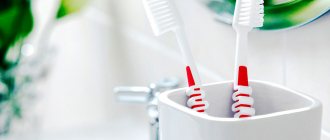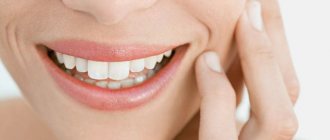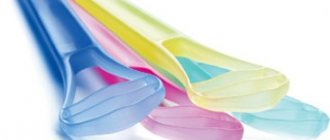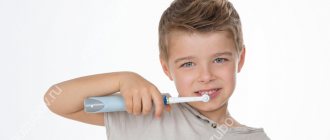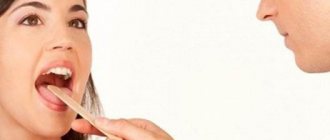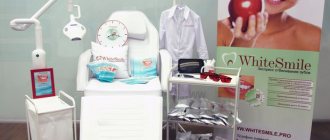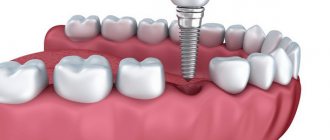Scientists have calculated that there may be more than a hundred million bacteria
toothbrush Thanks to a procedure such as disinfection of this hygiene item, it is possible to further increase the level of protection against various oral infections .
It is imperative to keep your cleaning device tidy and clean. A toothbrush sterilizer will help you with this.
Why do you need to disinfect?
Reference! As you know, a toothbrush is an item for individual use. It needs proper care every day.
This is done to ensure that the device functions properly and helps us effectively clean our teeth and oral cavity.
The product can very easily become contaminated and become a breeding ground for various types of infections.
There can be a lot of different bacteria on its surface.
Scientists say their number could reach hundreds of millions.
It is worth noting the fact that bacteria that cause digestive system disorders (for example, E. coli) can live and multiply on this personal hygiene item.
In addition, the presence of bacteria is often noted, which can cause quite serious infectious diseases (for example, staphylococci).
Know! If your immune system is working at its best, then your body can easily and without difficulty cope with bacteria that, thanks to the tool, enter the oral cavity.
And if is weakened, then this situation can lead to human illness.
You won't be able to kill all the bacteria that live on your toothbrush.
But thanks to timely and high-quality disinfection, there is a good opportunity to reduce their number .
How often should I sterilize?
Experts are divided on this issue.
For your information! Some people believe that disinfection needs to be done every week.
Others say the following. If you store your personal hygiene item correctly, you should disinfect it no more than once a month.
This can be done as long as you rinse the item with hot water after each cleaning.
After all, this procedure helps remove most possibly dangerous microbes.
Therefore, the choice remains personally for each person.
Cleanliness rules
When talking about how to care for toothbrushes, it would be wrong to ignore the topic of cleaning them. Some men and women believe that this personal hygiene item needs to be washed only in exceptional cases - for example, if it falls on the floor. This opinion is wrong.
The mouth is home to a huge number of microorganisms; Most of them are absolutely safe for humans, but some are opportunistic. Conditionally - because the immune system suppresses their vital functions. When brushing your teeth, they settle on the bristles and, once in suitable conditions, begin to multiply rapidly. With each subsequent use, a reverse exchange of bacteria occurs - some of them move from the brush to the mucous membrane. If the immune system weakens for some reason, it will be difficult for it to cope with a huge colony of microbes, and as a result, the person will become vulnerable to various diseases (most often respiratory).
During storage of the brush, clearly pathogenic flora can also fall on it - for example, E. coli (along with splashes spreading around when flushing water in the toilet), as well as any viruses and bacteria that become infected by airborne droplets (if someone sneezes in the bathroom without covering yourself, microparticles of saliva will end up everywhere, including on the heads of toothbrushes).
In addition, microscopic food debris can get stuck in the bristles - if they are not removed, they begin to decompose and become an additional source of infection.
Based on the above, hygiene rules come down to three main points:
- Before using your toothbrush for the first time, you need to wash it with 72% laundry soap and soak it in a soda solution for 10–15 minutes.
- Wash the brush daily before and after brushing your teeth using soap.
- Change the brush to a new one every three months.
We recommend: How to fold towels using the Konmari method
What happens if you don't do this?
If you do not disinfect on time, you can complicate your life. After all, the human oral cavity is inhabited by a variety of microbes.
Note! While everyone knows that it is necessary to brush your teeth every day and rinse your mouth with a special solution, many people do not think about the fact that they take care of their hygiene items.
In order to prevent the spread of harmful bacteria, disinfection measures must be taken.
If this is not done,
bacteria will multiply and the likelihood of various diseases will increase.
How to disinfect at home?
Today, there are quite a few ways in which you can disinfect your oral cavity cleaning device at home.
Stay up to date! Let's look at the most common of them:
- Mouth rinse. At the moment, stores offer a large assortment of such solutions. Some dentists believe that this product can be used not only for the oral cavity, but also for the hygiene product itself. It is necessary to immerse the cleaning device in the rinse aid once a week and keep it there for some time. It is believed that in this way it is possible to minimize the number of bacteria that may live on this hygiene item.
- Ultraviolet treatment of products for cleaning. A very effective and efficient method of disinfection. Statistically, ultraviolet light can kill almost all microbes located on the surface of the brush. Let's look at how this procedure works below. It is necessary to place the hygiene item in a special container and turn on the device. Processing will take five to ten minutes.
- Microwave disinfection procedure. This processing method can only be suitable for ordinary brushes. It is strictly prohibited to sterilize electric models in this way. This method is quite unique and not every person decides to use it. This method should be used very carefully. You may damage your hygiene item. Therefore, it is important to perform this procedure correctly. It is necessary to set adequate processing time and correct power.
- Disinfection in the dishwasher. Another extraordinary option for sterilizing this hygiene item. Be sure to use low temperatures. This is done so as not to soften the bristles and damage the brush.
- Treat the device with boiling water. Many dentists argue that you should not use this method of disinfection. The same information can be found on toothbrush boxes. It is believed that if you pour boiling water over your brush or put it in too hot water, you can quickly ruin it. Synthetic bristle fibers may become soft. In addition, microcracks may form that are invisible to the human eye. It turns out that boiling water can kill the majority of microbes, but it can also harm the brush itself.
- Treatment with acetic acid. Table vinegar can kill many germs. It is because of this that the method of disinfection with acetic acid arose. First you need to rinse the device in hot water. Then lower the product into a container with acid. Vinegar should not be diluted. Keep the device in this solution for a couple of hours. After the procedure, you should thoroughly rinse the brush in running water. It needs to be dried with the bristles facing up.
How to properly wash a brush?
Perhaps it's worth starting with the first use of a new brush. You can often hear advice to pour boiling water over the head with bristles before the first use. However, when freshly unpacked, the brush is sterile and free of any bacteria. Rather, this method helps soften the synthetic hairs a little so that they do not scratch the gums.
But with each further use, you should follow a number of simple rules:
- Before picking up a brush, remember to wash your hands with soap.
- Before brushing your teeth, rinse your toothbrush with warm water.
- After cleaning, the bristles are washed more thoroughly. You need to rub it with your finger under running warm water to free it from toothpaste and plaque.
- If desired, the brush can be washed with soap if it still seems dirty. But in general there is no such need.
- After rinsing, shake off any remaining water and let the brush dry in an upright position.
Ultraviolet sterilizer and its operating principle
Keep in mind! An ultraviolet sterilizer is a device that can kill all pathogenic bacteria on the surface of oral cleaning products.
In order for this device to work, it must be connected to an electrical current.
Depending on which model you choose, you will need a voltage of 220 Volts or batteries.
The main element in the sterilizer is a lamp that converts electricity into ultraviolet radiation.
This radiation treats the surface of the brush, thereby cleaning them from bacteria.
It is worth noting the fact that ultraviolet rays cannot kill bacteria directly. They change his DNA.
You should know! Due to this, bacteria lose the ability to further reproduce and, accordingly, exist.
All toothbrush sterilizers differ in the materials from which they are made .
There are cleaners made from ordinary ceramics, from ceramics with a special coating, and from plastic.
They may also
differ in power .
This is what determines how long the process of sterilizing a hygiene item will take.
Also, when choosing such a device, you should pay attention to the versatility of the models.
There are sterilizers in which you can process not only cleaning items, but also razors and manicure sets.
Best models
It is worth noting! Today, there are several of the most popular models of sterilizers for personal hygiene items.
Let's take a closer look at them:
- Esencia ESA555 . This sterilizer for toothbrushes was developed by a South Korean company. Its average cost in stores is about 4,000 rubles. Its special feature is that you can simultaneously put a brush, razor and various manicure items in it. This device is wall mounted.
- Gezatone T4 . In this case, the manufacturer is a French company. The cost of a sterilizer varies from 400 to 800 rubles. The device looks like a glass. It is designed for four toothbrushes. It only takes seven minutes of operation and your brushes will be disinfected. One of the advantages of this sterilizer model is the presence of a special tray. All the water that drips from toothbrushes flows into it. That is why this model has a long service life.
- Recesky . These sterilizer models are made in China. The cost is about 1200 rubles. It has a very original design. But in such a device it is possible to disinfect only one toothbrush. But despite this point, the device is very popular. The unique design lies in the fact that each model is made in the shape of a penguin, panda or owl. This toothbrush sterilizer is battery-powered and therefore can be taken with you on trips.
- Timson. This device is made in Russia. Its cost is about 650 rubles. The sterilizer is designed to disinfect only one brush. It has a transparent lid. Thanks to this, you can track the operation of the device. The duration of the process is 7 minutes.
- Orasafe Rose ESA100. The device is manufactured by a Korean company. The sterilizer is designed for two toothbrushes. Unlike the Russian analogue, there is an opaque cover with a built-in mirror. The difference is that in addition to the sterilizer, you get a toothbrush, tongue scraper and batteries. A similar device costs from one thousand rubles on the Russian market.
- Zero germ. The sterilizer is made in Korea. Has an unusual design. Costs approximately 800 rubles. Thanks to the device, you can disinfect two toothbrushes at the same time. The ultraviolet lamp is located in the middle of the device and simultaneously affects two brushes at once.
Dr.Meng Disinfection Toothbrush Holder
Disinfector for toothbrushes
Dr.Meng Disinfection Toothbrush Holder will be the suitable equipment to completely remove bacteria on your brush, ensuring your oral health.
Studies have shown that 1 toothbrush after 3 weeks of use contains about 1 million bacteria.
Conventional cleaning methods, such as rinsing with salt water, may not completely remove germs.
Highly effective disinfection
Dr.Meng's sanitizing toothbrush holder disinfects toothbrushes with non-toxic UV rays. To use this feature, users simply need to press and hold the Power button for 3 seconds.
Safety of use
To ensure the safety of users during sterilization, a bright light will indicate the working status of the device.
In addition, with the intelligent infrared human body sensor function, the sterilizer will automatically stop working when someone approaches, and continue sterilizing after the person leaves.
Robust design
Dr.Meng sanitizing toothbrush holder is made of high quality ACA plastic and silicone materials, durable and non-toxic.
Placement of smart brushes and toothpaste
The brush spacing on the Dr.Meng sterilizer is designed to be expansive to make brush placement easier without the two brushes touching each other, avoiding bacterial contamination.
Convenient holder
In addition to its disinfection function, Dr.Meng can also be used as a convenient toothpaste holder.
Dr.Meng's sanitizing toothbrush holder has the ability to automatically receive toothpaste from the installed tube. According to the mechanical principle, the pressure plate is designed to squeeze out the paste, and it is also easy to adjust the amount of paste as desired.
Up to 5 months of use without recharging
The Dr.Meng Disinfection Toothbrush Holder is powered by 2 x 2600mAh lithium batteries. It can be used for about 5 months after fully charged.
Durable mount is not afraid of moisture
Using a wall adhesive plate allows you to save bathroom renovations and avoid the need for a drill or hammer drill. It is enough to degrease the surface and press the plate against it, and after 72 hours the fastening will gain full strength. Quality double-sided adhesive tape from 3M provides strong adhesion and adhesive durability in wet bathroom conditions.

